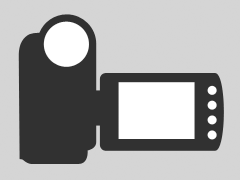Cover of asemic TLP (Tacky Little Pamphlet) by IUOMA member Jason Motsch (Conneaut Lake, Pennsylvania, USA)
April 15, 2016 - Jason Motsch is making some very interesting visual poetry and asemics these days. He sent a new TLP of asemic calligraphy that I am thrilled to share. This is a conventionally folded TLP – in the tradition of Eerie Billy Haddock – with pages that are approximately 2 X 3 inches. (You can click to enlarge.)
In this TLP, Jason Motsch explores glyph-like constructs and various kinds of non-linear and organic forms. Distinct forms emerge in the TLP, and a play emerges that tests and questions the boundaries between these forms and the notion of enclosure. The work definitely suggests language, although it cannot be read in a conventional way. The forms mimic poetry rather than prose.
The language-letter references are fairly consistent. Sometimes the shapes resemble the deconstructed letters that often appear in font-generated asemics. In other places, Jason Motsch transitions into an automatic writing mode (via Surrealism) where recognizable images seem to lurk inside or be entwined with the flow of asemic text.
Back cover of asemic TLP by Jason Motsch (Conneaut Lake, Pennsylvania, USA)
Jason Motsch included a note:
All this came in a nicely decorated envelope:
Many thanks to Jason Motsch!
Comment
-
Comment by De Villo Sloan on April 16, 2016 at 2:50pm
-
BTW - here is a HOT piece of Network news I will pass on only to you - faithful friends who actually look at my blogs. I get the scoop!
Richard Canard, Diane Keys & Lucky Pierre are meeting today in Illinois! I wish I could be a fly on the wall! Don't you? This is historic.
Diane is doing an online interview with Richard. You can submit questions via the Trashpo group on FB. Maybe there will be more coverage?
Remember, you saw it here first!
-
Comment by De Villo Sloan on April 16, 2016 at 2:25pm
-
res, I hope the asemicists here add "sigil" to the arcane discourse of asemics.
You can see from the blog I am using the term "glyph" to describe asemic symbols, including those created by Jason Motsch. "Glyph" is imprecise and "asemic symbols" is downright contradictory. Your invocation of "sigil" also supports my point here that asemic writing & automatic writing are close or possibly the same thing in many instances. I keep threatening to produce a treatise upon this subject but have not yet done so.
The current anti-asemic camp, shall we call them "The Assault on Asemics"?, contend the label "asemic" is untenable. Australian poet Pete Spence, for instance, claims all the asemic work we are seeing is either (1) visual poetry or (2) abstract art.
To me, their misreading is obvious, but they don't agree, of course. They say that it is impossible to create something that is "meaningless." All these asemic constructs have meaning, they contend.
What they are missing is that "asemic" - as I see it - refers to conventional reading & the conventional way language functions. So asemic writing can "mean," but it cannot be "read" in the way you would read a poem on the page. With asemic writing, the sign has been dismantled. It cannot "mean" the way language "means." (The only exception is that it can refer to the notion of language.) The signifier and signified have been disconnected (to use linguistics). Asemic writing might be viewed as the perfect code: It can never be cracked because in the end "There is no there there." But in a Romantic sense (as in Romanticism) you might feel something or intuit something. But that "meaning" is ineffable, subjective & probably temporal.
All this is leading to my final point that I do not believe a "sigil" is exactly asemic. The structure is very similar to a conventional symbol but not identical. There is an aspect of conventional reading. But the term has enough variance & presents an ideal involving language that is very useful - better than "glyph." So this has been a great discovery, IMHO.
-
Comment by De Villo Sloan on April 15, 2016 at 8:59pm
-
Richard! Just when I have been pondering, "Where's Richard?"
Res is so good. I had to look up "sigil." I do like that symbol, and it caught my eye. I was going to do a detail scan, in fact but the thing was stretching out. So I'm glad res spotted it too.
-
Comment by Richard Canard on April 15, 2016 at 5:52pm
-
15.04.16 Dare De Villo S., ... a personal & distinctive asemic contribution from Mister Jason Motsch. ....& the res nullius commentary concerning the "Chaos sigil"... I am always amused & or enlightened (although the so-called "enlightenment" always seems to be merely temporary) by what there is to see & witness here. Thanx for posting. "Sincelery," Richard Canard
© 2025 Created by Ruud Janssen.
Powered by
![]()










You need to be a member of International Union of Mail-Artists to add comments!
Join International Union of Mail-Artists